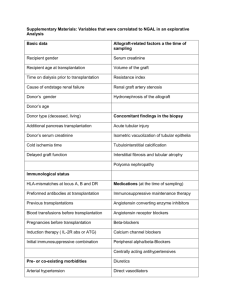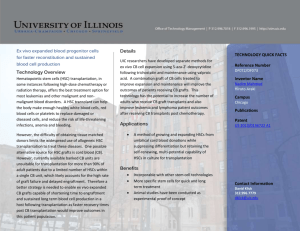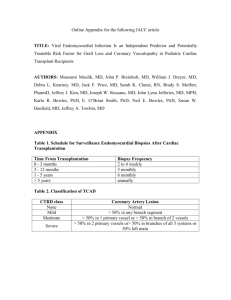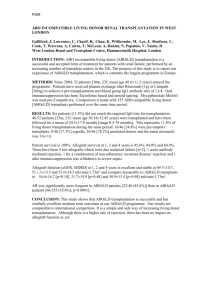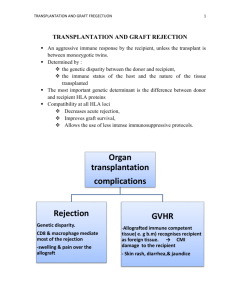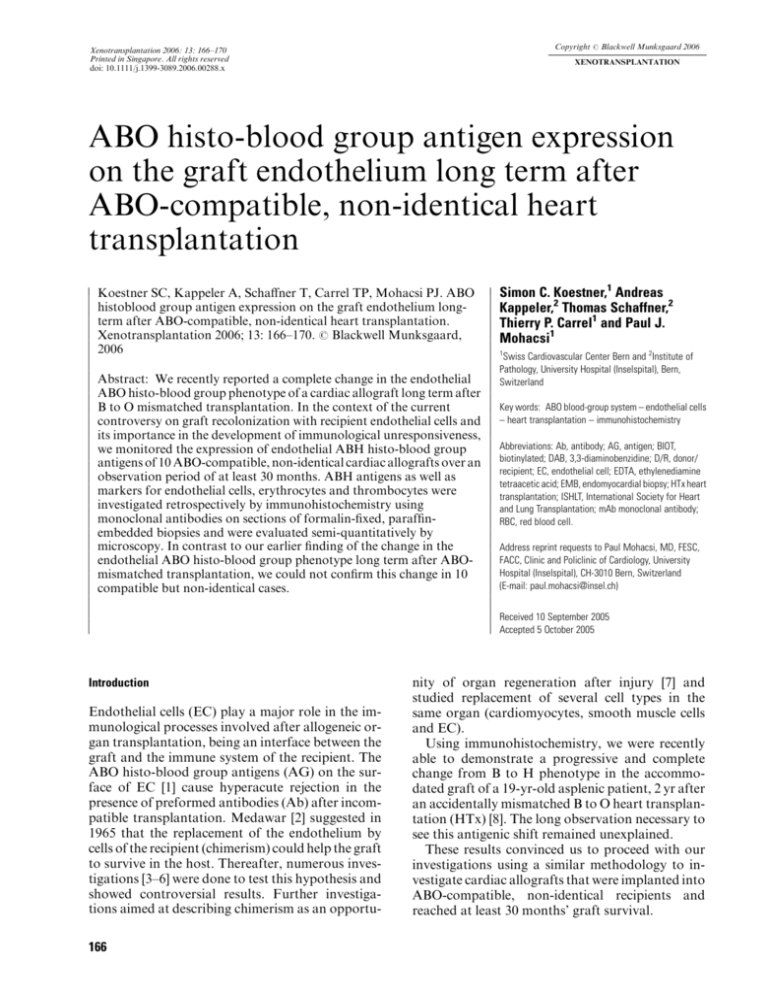
Copyright r Blackwell Munksgaard 2006
Xenotransplantation 2006: 13: 166–170
Printed in Singapore. All rights reserved
doi: 10.1111/j.1399-3089.2006.00288.x
XENOTRANSPLANTATION
ABO histo-blood group antigen expression
on the graft endothelium long term after
ABO-compatible, non-identical heart
transplantation
Koestner SC, Kappeler A, Schaffner T, Carrel TP, Mohacsi PJ. ABO
histoblood group antigen expression on the graft endothelium longterm after ABO-compatible, non-identical heart transplantation.
Xenotransplantation 2006; 13: 166–170. r Blackwell Munksgaard,
2006
Abstract: We recently reported a complete change in the endothelial
ABO histo-blood group phenotype of a cardiac allograft long term after
B to O mismatched transplantation. In the context of the current
controversy on graft recolonization with recipient endothelial cells and
its importance in the development of immunological unresponsiveness,
we monitored the expression of endothelial ABH histo-blood group
antigens of 10 ABO-compatible, non-identical cardiac allografts over an
observation period of at least 30 months. ABH antigens as well as
markers for endothelial cells, erythrocytes and thrombocytes were
investigated retrospectively by immunohistochemistry using
monoclonal antibodies on sections of formalin-fixed, paraffinembedded biopsies and were evaluated semi-quantitatively by
microscopy. In contrast to our earlier finding of the change in the
endothelial ABO histo-blood group phenotype long term after ABOmismatched transplantation, we could not confirm this change in 10
compatible but non-identical cases.
Introduction
Endothelial cells (EC) play a major role in the immunological processes involved after allogeneic organ transplantation, being an interface between the
graft and the immune system of the recipient. The
ABO histo-blood group antigens (AG) on the surface of EC [1] cause hyperacute rejection in the
presence of preformed antibodies (Ab) after incompatible transplantation. Medawar [2] suggested in
1965 that the replacement of the endothelium by
cells of the recipient (chimerism) could help the graft
to survive in the host. Thereafter, numerous investigations [3–6] were done to test this hypothesis and
showed controversial results. Further investigations aimed at describing chimerism as an opportu166
Simon C. Koestner,1 Andreas
Kappeler,2 Thomas Schaffner,2
Thierry P. Carrel1 and Paul J.
Mohacsi1
1
Swiss Cardiovascular Center Bern and 2Institute of
Pathology, University Hospital (Inselspital), Bern,
Switzerland
Key words: ABO blood-group system – endothelial cells
– heart transplantation – immunohistochemistry
Abbreviations: Ab, antibody; AG, antigen; BIOT,
biotinylated; DAB, 3,3-diaminobenzidine; D/R, donor/
recipient; EC, endothelial cell; EDTA, ethylenediamine
tetraacetic acid; EMB, endomyocardial biopsy; HTx heart
transplantation; ISHLT, International Society for Heart
and Lung Transplantation; mAb monoclonal antibody;
RBC, red blood cell.
Address reprint requests to Paul Mohacsi, MD, FESC,
FACC, Clinic and Policlinic of Cardiology, University
Hospital (Inselspital), CH-3010 Bern, Switzerland
(E-mail: paul.mohacsi@insel.ch)
Received 10 September 2005
Accepted 5 October 2005
nity of organ regeneration after injury [7] and
studied replacement of several cell types in the
same organ (cardiomyocytes, smooth muscle cells
and EC).
Using immunohistochemistry, we were recently
able to demonstrate a progressive and complete
change from B to H phenotype in the accommodated graft of a 19-yr-old asplenic patient, 2 yr after
an accidentally mismatched B to O heart transplantation (HTx) [8]. The long observation necessary to
see this antigenic shift remained unexplained.
These results convinced us to proceed with our
investigations using a similar methodology to investigate cardiac allografts that were implanted into
ABO-compatible, non-identical recipients and
reached at least 30 months’ graft survival.
Endothelial blood group AGs in compatible HTx
Materials and methods
Among 19 patients with ABO-compatible but nonidentical HTx of 108 heart-transplanted patients from
the cardiac transplant program at the University Hospital Bern (Switzerland), 10 cases were selected retrospectively because of their long observation time (at
least 30 months). Table 1 shows the clinical features
of each selected patient, including age, sex and
histo-blood group of both recipient and donor.
For each patient, routine endomyocardial biopsy
(EMB) samples had been collected during the posttransplantation observation period. They were obtained from the right ventricle with a French 5.4
bioptome [9] according to standard follow-up
protocols. All samples had been fixed in 4% neutral-buffered formaldehyde and processed to paraffin blocks according to standard protocols.
Hematoxylin & eosin stainings of all biopsies were
used to assess the rejection grade according to International Society for Heart and Lung Transplantation (ISHLT) criteria [10]. From each patient, one
biopsy was taken in the early post-transplant period
(1 to 2 weeks) and three samples were taken late in
the observation period for the evaluation of the expression of ABH AG on EC using immunohistochemistry. To this end, serial sections of paraffinembedded tissue were cut at 2 to 3 mm, dewaxed and
stained with the following Ab: mouse-anti-A monoclonal antibody (mAb) (clone 81FR2.2; DakoCytomation, Glostrup, Denmark), diluted 1 : 100,
mouse-anti-B mAb (clone 3E7; DakoCytomation),
diluted 1 : 40, mouse-anti-H mAb (clone 92FR-A2;
DakoCytomation), diluted 1 : 20 and mouse-antiCD31 (clone JC/70A; DakoCytomation), diluted
1 : 20, to demonstrate EC. To exclude a possible antigenic transfer from erythrocytes or thrombocytes
to the EC, we also stained samples with mouse-antiglycophorin A (clone JC159; DakoCytomation), di-
luted 1 : 200 and mouse-anti-CD42b (clone MM2/
174; Novocastra Laboratories, Newcastle-uponTyne, UK) Ab. To restore formalin-fixed AG (except for glycophorin A), dewaxed slides were pretreated either by boiling in citrate buffer (A antigen
in a pressure cooker at 1211C for 10 min, H antigen
and CD31 in a microwave oven), by boiling in ehtylenediamine tetraacetic acid (EDTA) in a microwave oven (CD 42b) or by digestion with Pronase E
(Sigma, St Louis, MO) (B antigen) before the application of the primary Ab. Two different secondary Abs were used: rb-a-mo IgM/BIOT (Dako
Cytomation) for A, B and H antigen stainings and
gt-a-mo Ig/BIOT (DakoCytomation) for CD31,
glycophorin A and CD42b stainings. Sections
were developed in 3,3-diaminobenzidine (DAB, Sigma)FH2O2, counterstained with hematoxylin
and mounted. Since the H antigen is often difficult
to visualize using standard immunohistochemistry,
we used for this AG an amplification technique
based on the formation of complexes of DAB with
biotinyl tyramide. Tissues with known ABH type
were included as positive controls.
The density of vessels positive for A, B or H antigen was established by counting the number of
positive capillaries, venules and arterioles per defined surface area at a magnification of 400, using
a light microscope equipped with an eyepiece with a
10 10 counting grid. The results were expressed in
percentages of capillaries positive for either A, B or
H antigens compared with the total amount of capillaries (defined by the density of capillaries positive
for CD31).
Results
Five patients (#13, 40, 56, 66 and 73) showed no or
very weak modification of their antigenic properties, keeping the AGs of the donor graft on all the
Table 1. Clinical features for each selected patient, including D/R blood group match, patient number (#), age, gender, total observation time (obs time)
and percentage (%) of recipient antigen positive vessels
% of vessels positive for recipient antigena
BG match
Patient #
Age at HTx
Gender
Obs time (months)
Earlyb
O to A
2
17
24
37
47
56
66
73
13
40
61
55
49
47
31
48
33
62
20
58
M
M
M
M
M
M
M
F
M
M
101
102
78
65
56
31
43
37
97
65
3.4
5.2
0.5
0.0
2.4
0.0
0.0
0.0
0.1
0.0
O to B
A to AB
B to AB
Late (months)
12.8 (96)
4.8 (79)
2.8 (65)
1.5 (56)
16.4 (40)
0.0 (24)
0.0 (35)
0.0 (24)
0.3 (85)
0.0 (53)
13.0 (98)
4.5 (88)
2.6 (73)
3.9 (60)
3.3 (50)
0.0 (30)
0.0 (41)
0.0 (31)
0.0 (93)
0.0 (59)
6.9 (101)
1.5 (102)
2.0 (78)
1.8 (65)
2.6 (56)
0.0 (31)
0.0 (43)
0.0 (37)
0.2 (97)
0.0 (65)
a
Compared with CD31 1 vessels ( 5 100%).
Early 5 first month (o2 weeks post-Htx).
HTx, heart transplantation.
b
167
Koestner et al.
biopsies we analyzed (see Fig. 1 and Table 1). All O
to B transplants as well as the B or A to AB transplants belong to this group. The maximal posttransplant follow-up for these patients was 97
months. The five other patients with O to A compatible mismatch (#2, 17, 24, 37 and 47) showed
weak to moderate presence of the AG of the recipient on a maximal post-transplant follow-up of 102
months. Figure 1 shows two biopsies of a patient 2
weeks and 97.5 months after O to A transplantation
with moderate appearance of the recipient’s AG
several months after transplantation (Fig. 1(A–D))
and two biopsies of an other patient 1 week and 43
months after O to B transplantation without any
appearance of the recipient’s antigen (Fig. 2(A–D)).
Figures 1 and 2. Expression of ABH antigens in two ABO-compatible non-identical transplanted patients (left side 5 anti-H;
right side 5 anti-A (1B and 1D) and anti-B (2B and 2D)). Patient #2 (O to A): 1A and 1B 5 2 weeks post-Htx; 1C and
1D 5 97.5 months post-HTx. Patient #66 (O to B): 2A and
2B 5 1 week; 2C and 2D 5 43 months post-HTx. Despite the
appearance of some vessels positive for the recipient’s antigen
early after O to A transplantation (1B), the graft of patient #2
remains strongly of blood group O (1C and 1D). The graft of
patient #66 never showed any antigen of the recipient (2B and
2D).
168
The control stainings with glycophorin A (platelets) and CD42b (erythrocytes) allowed us to
attribute the presence of ABH antigens only to EC
(see Figs 3(A)–4(D)).
Discussion
We monitored the expression of endothelial ABH
antigens of 10 ABO-compatible but non-identical
cardiac allografts that reached a follow-up observational time of at least 30 months post-HTx. In
contrast to our earlier finding of a complete change
in the endothelial ABO histo-blood group phenotype long term after B to O mismatched transplantation [8], we could not confirm this change in 10
compatible but non-identical cases.
Figures 3 and 4. Figures 3(A) and 4(A) depict recipients antigens (anti-A) (anti-B not shown, since this match showed no
occurrence of recipient antigens). 3B and 4B 5 anti-glycophorin
A (red blood cell (RBC) antigen). 3C and 4C 5 anti-CD 31
endothelial cells (EC). 3D and 4D 5 anti-CD42b (thrombocytes). The positive-looking area in 4b represents antiglycophorin A positive cells ( 5 RBCs) of blood group A
(positive in 4A 5 anti-A) from the recipient and not the endothelium of the graft (anti-CD31 ).
Endothelial blood group AGs in compatible HTx
A change in the endothelial phenotype after
transplantation of solid organs has been presumed
to play a potential role in the acceptance of the allograft [2]. Several studies published on this topic used
different rationales and technical approaches, and
showed controversial results [3–6].
EC serve an important role in augmenting immune responses through enhanced expression of
major histocompatibility complex class II Ag. Immune-mediated vascular injury associated with rejection requires re-endothelialization to restore
vascular integrity. The origin of the reparative EC
can be determined when ABO antigens expressed on
these cells differ in the donor and recipient. Therefore, O’Connell et al. [6] stained serial EMB for
ABO antigens in 34 (13%) compatible, non-identical cardiac allograft recipients of 268 cardiac transplant procedures. In 10 of these cases the allograft
EC expressed the characteristics of the recipient
(five partial and five complete) within 7.5 months
after transplantation.
Because of the poor outcome of ABO-incompatible
transplanted cardiac allografts, these types of
investigation, especially in the long-term follow-up,
are very rare. In infants transplanted in the first
months of life and whose grafts further accommodated, perhaps as a result of delayed development of antigraft antibodies, no chimerism was observed [11].
Our present information suggests that, even
though the methods used are similar and even
though the observation time is quite long, no complete change in the graft antigenicity occurs in compatible non-identical ABO match. Limitations of
our current results are as follows:
Everybody working in the area of ABH tissue
immunohistochemistry is aware of the tricky
situation with respect to reliability and reproducibility of the results. In fact, before starting
our investigations, we validated our immunohistochemical technique during a period of
almost an entire year. The aim was to improve
the signal strength by using an amplification
method called PolyMICAs [8]. This amplification technique was especially important for the
visibility of the H antigen. Our current work did
not allow us to reuse the PolyMICAs technique, as this product is no longer available on
the market. Therefore, we adjusted our amplification methodology, this time with biotinyl
tyramide.
The patchy pattern of the positive area illustrated by immunohistochemistry may raise further
discussions about the reliability of our data.
Therefore, we counted all positive vessels obtained on the entire surface of all biopsy speci-
mens. Some investigators may argue that the
patchy area may represent a location of immune-mediated vascular injury associated with
rejection requiring re-endothelialization. These
kinds of pathophysiological thoughts might be
well taken. Why such a kind of patchy pattern
occurs without any obvious correlation to cellular rejection and without any time dependency
on the post-Htx period and the respective levels
of Ab (data published elsewhere [12]), however,
remains unanswered.
The above-mentioned problems led us to use different controls, namely CD31 (as an EC marker),
CD42b (as a platelet marker) and glycophorin A (as
an RBC marker).
Taken together, in ABO-compatible grafts, published data do not allow us to understand the rules
for endothelial chimerism after transplantation,
because these studies used different methods and
were done in different clinical settings. The current
work in our laboratory investigates whether and
under which preferential conditions the possible
change of ABO phenotpye may occur (e.g., after
vascular injury resulting from ABO-incompatible
organ transplantation).
Acknowledgments
This work was supported by the Katharina HuberSteiner Foundation, Bern, Switzerland.
References
1. NYDEGGER U, MOHACSI P, KOESTNER S et al. ABO histoblood group system-incompatible allografting. Int
Immunopharmacol 2005; 5: 147.
2. MEDAWAR P. Transplantation of tissues and organs: introduction. Br Med Bull 1965; 21: 97.
3. LAGAAIJ E, CRAMER-KNIJNENBURG G, VAN KEMENADE F
et al. Endothelial cell chimerism after renal transplantation
and vascular rejection. Lancet 2001; 357: 33.
4. THIELE J, VARUS E, WICKENHAUSER C et al. Regeneration of
heart muscle tissue: quantification of chimeric cardiomyocytes and endothelial cells following transplantation.
Histol Histopathol 2004; 19: 201.
5. SEDMAK D, SHARMA H, CZAJKA C, FERGUSON R. Recipient
endothelialization of renal allografts. Transplantation
1988; 46: 907.
6. O’CONNELL J, RENLUND D, BRISTOW M, HAMMOND E. Detection of allograft endothelial cells of recipient origin
following ABO-compatible, nonidentical cardiac transplantation. Transplantation 1991; 51: 438.
7. QUAINI F, URBANEK K, BELTRAMI AP et al. Chimerism of the
transplanted heart. N Engl J Med 2002; 346: 5.
8. KOESTNER S, KAPPELER A, SCHAFFNER T et al. Histoblood group change of the graft from B to O after
mismatched heart transplantation. Lancet 2004; 363:
1523.
169
Koestner et al.
9. CAVES P, SCHULZ W, DONG EJ, STINSON E, SHUMWAY N.
New instrument for transvenous cardiac biopsy. Am J
Cardiol 1974; 33: 264.
10. BILLINGHAM M, CARY N, HAMMOND M et al. A working
formulation for the standardization of nomenclature in the
diagnosis of heart and lung rejection. J Heart Transplant
1990; 9: 587.
170
11. WEST LJ, POLLOCK-BARZIV SM, LEE KJ et al. Graft accommodation in infant recipients of ABO-incompatible heart
transplants: donor ABH antigen expression in graft biopsies. J Heart Lung Transplant 2001; 20: 222.
12. MOHACSI P, RIEBEN R, SIGURDSSON G et al. Successful management of a B-type cardiac allograft into an O-type man with
3½-year clinical follow-up. Transplantation 2001; 72: 1328.



